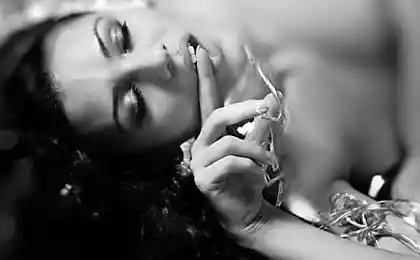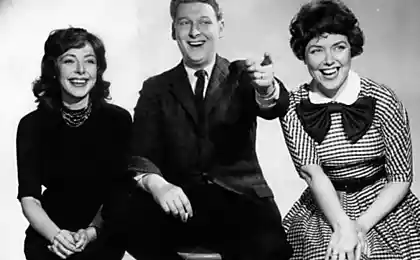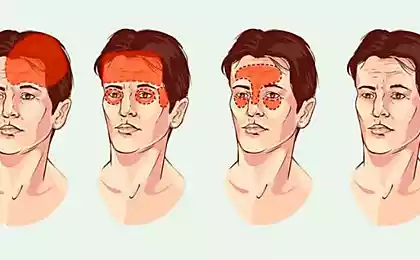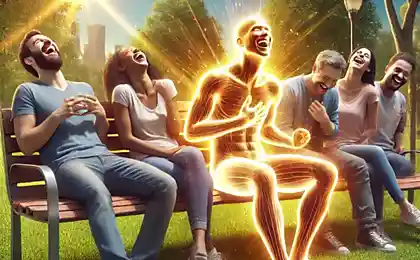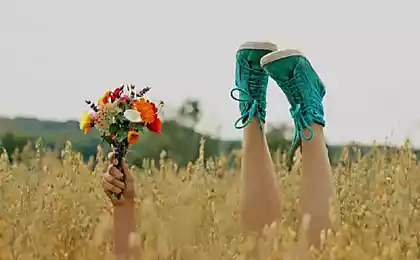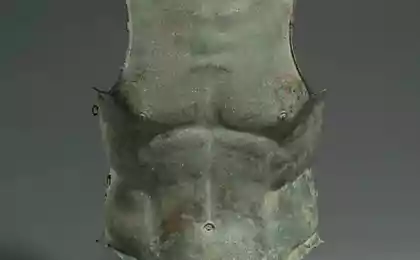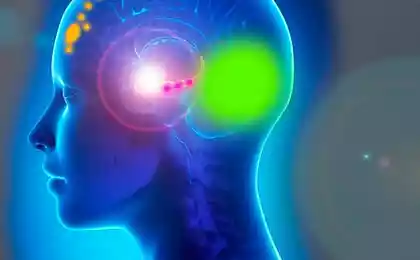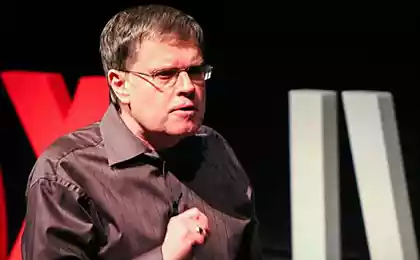907
Anish L. Dillon: 3 pairs of senses —find out what emotion you are blocking
If you split the word "emotion" (emotion) into two constituent parts — "e" and "motion", you will see that it was originally formed from Latin roots, meaning outward motion.This definition corresponds well to racianska understanding of human emotions. At its core emotion is nothing like the movement of the plasma, the wave energy transmitted through the liquid contents of the body in desire for expression and release.
So out of point of view does not matter to us really matter, when we mourn the lost beloved, or angry at some offensive remark. But it certainly helps racianska the therapist to understand the mechanics of restoring a healthy surge in the body to open the door to happiness, greater vitality and well-being.
Sixty six million nine hundred ninety six thousand two hundred four
Sam Reich has traced the emergence of emotions to their most primitive and basic form, by choosing as an example a single celled organism, the amoeba. With a microscope he saw that the plasma within the cell of an amoeba in the sky, in the direction of the source of pleasure and retracts, retreating from the source of pain.
This two-way traffic, or, as Reich liked to call it, "two-way emotion of protoplasm".
The pursuit of pleasure is the movement from the nucleus to the periphery, while the desire to avoid pain causes the movement in the opposite direction, compression from the periphery to the core.Reich believed that the basic pulsation in two directions common to all living organisms and is a fundamental principle of human expression: we all want to feel pleasure; we all want to avoid pain. Reich also pointed to the fact that the movement as a means of expression, is an inherent property of living organisms that distinguish them from the rest of nature. To be alive means to move; to move means to Express.
Seventy five million two hundred eighty four thousand four hundred eleven
All this looks obvious, but leads to a significant conclusion: whether we like it or not, we are all emotional beings. Feelings are part of a set called "life" and the emotional expression of these feelings is a natural and necessary movement of our energy.
If we suffocate, suppress, thus we suppress the very life-force.
From this point of view it is easy to see the basic conflict between human nature and our so-called socially acceptable behavior. In "advanced" societies, the less the person shows his emotions, the more civilized it is considered.
It reminds me of the famous "bogatoi upper lip" of Britons,when not to show emotions in the moments of utmost stress was considered the pinnacle of the manifestation of good manners and breeding.
I don't remember the title of the book, but I do remember that there was a quote from the diary of a British lady trapped in the besieged Lucknow during the Indian mutiny in 1857. "This morning major so-and-so was beheaded by a Cannonball while shaving". This was all her diary: a pedantic enumeration of the horrors of the siege with the brutal suppression of the emotions.
We Americans are not so good at hiding emotions, but the General approach remains the same. For example, I remember how we joked with her sisters that all belong to the family Well. And that our real name is not Dillon, as Well, because every time when greeting, we asked each other: "How are you?"the answer was always, "Well!»
It's American style: look good, keep smiling and be confident that everything is fine. And if this facade with the inscription: "I'm good" begins to sneak in any unwanted negative emotions, to neutralize them always have the latest derivative of prozac or valium. Of course, these clever little pills along with your suffering will ruin your ability to be happy, but this is the price that people are willing to pay for that all was still nice and fine.
This position is characteristic not only for Americans and Europeans. In all highly organized cultures, including in Japan, China, Egypt and India, at all times required to abide by the strict formality in social interaction and usually prohibits the expression of feelings.
Reich's message to the world is that the process of civilization has gone too far in the direction of emotional control. For that you have to pay too high a price to make people neurotic, incapable of truly enjoying life.
This is particularly true today. Thanks to the development of science, people have succeeded in making a comfortable life. The world is filled with all sorts of technological marvels that make life easier and provide various forms of leisure. But parallel with this the destruction of the vital forces, almost deprived us of the ability to enjoy their own achievements.
We need to restore your emotions, to regain the love of life.
Therefore, Charles Kelly took over the base Rachinsky a surge of "pleasure — anxiety" and has developed a more sophisticated model for working with clients.
He found it correct and useful to consider emotions in terms of not one, but three "pairs of senses."
These three "couples feelings»:
anger — love;
the fear — trust;
the pleasure — pain.
Each of the three negative emotions — anger, fear and pain associated with various aspects of pulsation. Anger is associated with the movement outward from the core to the periphery. Fear is associated with the movement inward, from the periphery to the core. The pain associated with the convulsive quality of the energy discharge, the rapid compression and subsequent relaxation of muscles. We feel it when I laugh, cry, experience the orgasm.
Each of the negative emotions being blocked, characterized by the method is retained in the body through muscular tension. This allows a skilled therapist to read the body of the client and to identify the predominant blocked emotion. To a certain extent, we can divide people into holding the anger, holding the fear and pain holding.
It helps to decide where to start the process of releasing blocked emotions and the restoration of healthy pulsation. Of course, this does not mean that angry people, holding anger. Inside us all lives a full spectrum of emotions. This classification only refers to what the habit has been formed in man for many years and what type of emotions are mostly blocked.
Three positive emotions are also associated with pulsation. Love flowing out to others from the core to the periphery. Trust is a form of receptivity that allows the world to penetrate. Pleasure is a state of well-being, involving the whole body.
As we will see further, from the fact that negative and positive emotions associated with surge, followed by important conclusions, because the lack of understanding that exists in terms of how to deal with negative emotions directly affect our ability to feel positive feelings.
Anger — Love
Anger is energy flowing outward. Its release it's easy to see, watching the way quarrel, especially between men. For example, two guys in the bar talk about football. One says "49-th of San Francisco" is the best team in the world, and the other with a sneer of disgust, she says: "recently, the "Ninth" not worth a damn". The first one immediately feels insulted, gets angry and hits the second in the jaw. Classic starts a drunken brawl.
Anger is a tough, explosive and aggressive expression of energy the sudden release from the core to the periphery — and so the fist fight, in fact, is nothing other than a continuation of the energy pulse moving to the outside.
The same is true for weapons. When an old Western two cowboys start a fight and "cling to guns" glittering revolvers, and bullets are a continuation of the angry energy. By the way, in the United States a large number of people dying from gunshot wounds. This happens due to the presence and availability of weapons, lengthening and amplifying pulse energy of anger.
However, being civilized people, we are trained from childhood not to Express anger and, generally speaking, we do everything in our power to keep it. This effort, motivated by the best impulses, causing muscle tension and hardening.
Armor of rage is located on the periphery of the body, because the energy that has stopped moving outward. The man restraining anger, usually strong wrists and hands with hard muscles, his mouth and jaw are almost always tense and a barrel chest appears as if it defies the world. Such people evoke the feeling that they could barely contain their emotions; should you accidentally move it, or step on the foot, or something to say — and they will immediately explode.
As I just mentioned, social education teaches us to block anger — except in special situations, such as war. But the difficulty caused by this approach, is that it also impedes love.
Love is soft, gentle, sympathetic expression of our energy, moving outward. Despite strong differences, love and anger are moving on the same highway in the same direction — from the nucleus to the periphery.If one aspect directed outward expressions blocked, it is likely to be blocked by another aspect. And love is much softer, more subtle sense.It will not be able to penetrate the hard layer of chronic stress, habit formed to block the anger. Even if deep in your core you seek to Express love, strive to reach out to others in its expansive movement, it will fail. On the highway traffic jam, traffic is blocked and nothing can move.
This is a classic dilemma created by social morality. Demand from us that we are not angry, and instead would be loving and compassionate.We are taught to "love your neighbor", "turn the other cheek", not understanding and not taking into account the dynamics of the involved energies.
To suppress anger and to be loving is simply impossible. Yes, you can bring the love to a certain idea, the intellectual concept and pretend that you love others, you love humanity, you care about the poor and disadvantaged. But the real, warm, genuine love is a living energy that needs movement and expression, and if the path expression is blocked clad in body armor, it can never reach the other person.
To start leaking love, anger needs to be expressed and released.
Due to ignorant parenting people do not know what to do with anger, while the solution is very simple: anger you just need to throw away, to throw out from yourself is the only thing that will help. It sent out a wave of energy that must be expressed and discharged. Of course, this does not mean that we should start yelling at each other, get into fights and carry guns. There are safe, reasonable ways of expression of anger, not causing harm to others. We can lock ourselves in a room, get a pillow and swung her imprint in the floor or beating her with his fists. We can do meditation techniques that promote emotional expression, for example, Dynamics. We can cry when we're alone in the car with their glasses, although this requires some caution and vigilance in order not to get into an accident (better to Park).
After the discharge of anger and the release of the inner motorway, the likelihood that love will begin to flow and find expression, is significantly increased. This explains the habit which produced some long living together of couples to argue and then make love — "fucking and fighting" ("fuck and fight"), as it is sometimes called.
They themselves without knowing it, these couples are trying to get rid of blocked energy and feel the presence of her love. In the past, women were hard to Express your anger directly. In the Victorian era, for example, tight corsets and chilling clothes reflected a corresponding emotional state of the hard constraints. It was based on the belief that no matter how legitimate nor was the anger of women, men will always be stronger and will not allow its expression, forcing the woman to swallow my rage.
Most often, anger in women is released in a hysterical seizure, which is a form of helpless rage. It is hysteria often faced Freudians, starting in the early twentieth century to the study of the female psyche. Thanks to the liberation of women and the new law directly to Express their emotions, nowadays hysteria is not as common.
Other traditional women's way of dealing with anger is grumbling. It leads to success in turning men henpecked, but in fact is a distorted form of anger. As well as hysteria, grumbling evolved from the inability to directly Express emotions.
Seventy six million forty nine thousand three hundred twenty
The Fear — Trust
Fear causes a person to shrink. This reduction, drawing energy inward, because in reality your basic survival instinct says, "Run away!"This desire to get out of a situation that is felt as a threat. To maintain the action, the body secretes adrenaline, and the animal inside you wants to run away, to flee.
In some situations, the flight is correct and feasible action. We've all seen video footage and photos depicting the September 11, 2001, when hundreds of people fled through the streets of Manhattan, escaping from the falling debris of the twin towers of the world trade center. Civilized behavior normally associated with suits, ties, briefcases and business way of life, was suddenly forgotten, and animal instinct took over and forced people to flee for his life.
In the process of education, the situation is quite different. Children are frightening family situations, but to escape from them. They are helpless and dependent on those very people — most often it is mom and dad, who are the cause of fear. Children can't run, and instead of fleeing in fear compressed.
At its core, this compression represents the deviation of the energy to the core of the movement inside, trying to escape from the periphery, where there is a danger. This compression can be caused by a thousand and one reasons, but mainly its appearance reflects the insecurity of the home environment.
The child in it, to protect themselves must remain vigilant. Unpredictability is a key component in the formula of fear. It is not that dad or mom is angry all the time, but that the tendency of one or both parents to sudden explosions creates an atmosphere of constant anxiety, constant expectations: "When will it happen? ". This atmosphere prevails in families where the alcoholic father, getting drunk, prone to physical violence. And unsafe, if the mother nervous, and she copes with stress only up to a point, and then suddenly "snaps" and attacks the child with a beating.
Also in my experience, acquired in the process of working with multiple clients, I know the type of people that hold fear, sometimes right in the womb, as it certainly is impossible to escape. For example, if the mother does not want pregnancy, her unspoken desire to have an abortion creates a climate of fear, affecting the fetus. Similarly, if the mother during pregnancy is in a constant state of stress, worried or afraid, these feelings are transmitted to the unborn baby. He experiences the frightening questions: "is it Safe?", "Do I have a right to be here?". Such a response emerges not on the level of thinking the fruit doesn't know the language — but is experienced by the organism at a primitive, instinctive level, causing the desire to contract energetically.
Retention of fear can emerge and shortly after birth, during the first eighteen months of life, during the so-called "oral stage", when the baby is in the most helpless state, and all day depends on maternal care.
Fear— unpleasant experience. This feeling of compression, which implies the logical conclusion that if you compress too much, then completely disappear and die. Focused on the fear of the child, therefore, protect themselves with armour, and from this feeling.
As a result, the shell of a person, holding the fear is deep inside the body, around the nucleus.
It shows two trends. The first is the outflow of energy from the periphery, where there is danger. Second — to protect the kernel itself from this offensive compressible energy.
In the case of anger, as we have seen, the carapace is located on the periphery to prevent the blow directed outside. In the case of fear deep inside is a kind of solidification, so that the energy pouring from the periphery inward, completely flooded the core.
Externally, the people blocking the fear, look thin and fragile, because their energy is held in the center. They usually have weak muscles of hands and feet, chest may look sunken and flattened. Often, energy is withdrawn from the eye, resulting in the blocking of fear people may be myopic. It is clear that such a person is hard to trust other people or the world around you, because trust requires openness and receptivity. Trust is the willingness to allow energy from the outside to penetrate your inside.
As fear, trust, moving with the phase of ripples inward, from the periphery to the core. It follows that if a person is enclosed in a shell that protects from fear, then this block will also prevent flow and soft flow of trust.
One of the first steps in working with fear is to help the client recognize and accept it, and that means dipping into the nucleus where it is fear. This is a more delicate task, than working with anger, because the person holding the fear in need is to feel safe. Need to he already had some trust — this will allow energy to move even deeper inside.
Discharge fear is not so explicitly, as the release of anger. It is usually accompanied by a loud high pitched sound, and as the inner shell starts to break down, and the tension is released gradually recovering the ability to trust.
On a psychological level, trust means that you can relax in society of another person, not being possessed of the usual chronic suspicion, such as: "This person looks friendly, but it is only because him I need something...»
This does not mean that trust has to be unconditional or blind. If the suspicion has a basis in reality, if the situation becomes bizarre or dangerous, it is useful to be able to recognize this and to take measures to protect themselves.
But mostly, trust is a stance which is as follows: "the World is not coming for me. I can move through life open and relaxed, allowing different events to influence me, to touch me, to influence me".
This is one of the most important results radianskoi practice: she helps clients regain the ability to open and close properly.Protection can be erected when fear is the cause. And when there is an opportunity to trust, they can be removed.
Pleasure — Pain
When a small child is truly crying or laughing, his whole body is in a state of healthy and natural pulsation. But if these feelings are suppressed and disrupted, the ripple is reduced so that the movement both inside and outside is minimized in the quest to silence unwanted or unacceptable feelings. The person holding the pain, all efforts were made to not feel, not to acknowledge what wants to be expressed. This method of containment or suspension of all ripple.
This happens when the child is hurt. For example, when a tease or distract the other children or when for some fault in his own family he was expelled and forced to stand in the corner at the time, as all the attention and love of parents is directed at other children.
I remember myself as a child was very angry at her younger sister, born two years after me because of all the attention that its occurrence was focused solely on me, suddenly got it. I hated the sister and often acted in relation to it really badly, so parents, trying to protect her, he kicked me out. I was left alone with his rage and tears, which could not be expressed, and gradually I learned to fall into a kind of numbness, to not feel.
Like anger and fear, there is a clear direction: the anger is directed outward, and fear inside. When blocking the same pain because of a desire to feel less reduced both stroke ripple, and gradually the whole body becomes insensitive.
As we have seen, the people who are holding anger, carrying a big charge of energy at the periphery, while the people who are holding fear, retain this charge in the nucleus. People are holding the pain, the intense charge is distributed throughout the body, from the core to the periphery.
As a result, these people can be tireless workers with incredible endurance — they can cheat laps in the pool long after everyone else gave up — but all this activity does not create a sense of liveliness and vitality. On the contrary, they felt the energy stagnation. They are characterized by the tendency to overweight because of fat accumulation in regions of tension helps to numb out feelings.
For people that block pain, the first step to healing is to increase the surge energy. The easiest way to accomplish this is through deeper breathing. This technique will inevitably lead the person into contact with painful feelings. If he can recognize and accept them, then, most likely, will begin deep cries and convulsive sobs, the tension is released and the body will gradually start to become more alive.
Again having experienced the pain and restoring normal pulsation in the body, people who hold the pain, open up huge opportunities for enjoyment, sensuality and joy. Very often the constant mind-numbing quality to block the pain gives a person to feel intense pleasure from the orgasm. The release of pain opens the capacity for orgasmic pleasure. published
©Excerpt from the book Anise L. Dillon "Tantric pulsation»
P. S. And remember, just changing your mind — together we change the world! ©
Source: body-work.ru/stati/anisha-l-dillon-otryvki-iz-knigi-tantricheskie-pulsatsii
So out of point of view does not matter to us really matter, when we mourn the lost beloved, or angry at some offensive remark. But it certainly helps racianska the therapist to understand the mechanics of restoring a healthy surge in the body to open the door to happiness, greater vitality and well-being.
Sixty six million nine hundred ninety six thousand two hundred four
Sam Reich has traced the emergence of emotions to their most primitive and basic form, by choosing as an example a single celled organism, the amoeba. With a microscope he saw that the plasma within the cell of an amoeba in the sky, in the direction of the source of pleasure and retracts, retreating from the source of pain.
This two-way traffic, or, as Reich liked to call it, "two-way emotion of protoplasm".
The pursuit of pleasure is the movement from the nucleus to the periphery, while the desire to avoid pain causes the movement in the opposite direction, compression from the periphery to the core.Reich believed that the basic pulsation in two directions common to all living organisms and is a fundamental principle of human expression: we all want to feel pleasure; we all want to avoid pain. Reich also pointed to the fact that the movement as a means of expression, is an inherent property of living organisms that distinguish them from the rest of nature. To be alive means to move; to move means to Express.
Seventy five million two hundred eighty four thousand four hundred eleven
All this looks obvious, but leads to a significant conclusion: whether we like it or not, we are all emotional beings. Feelings are part of a set called "life" and the emotional expression of these feelings is a natural and necessary movement of our energy.
If we suffocate, suppress, thus we suppress the very life-force.
From this point of view it is easy to see the basic conflict between human nature and our so-called socially acceptable behavior. In "advanced" societies, the less the person shows his emotions, the more civilized it is considered.
It reminds me of the famous "bogatoi upper lip" of Britons,when not to show emotions in the moments of utmost stress was considered the pinnacle of the manifestation of good manners and breeding.
I don't remember the title of the book, but I do remember that there was a quote from the diary of a British lady trapped in the besieged Lucknow during the Indian mutiny in 1857. "This morning major so-and-so was beheaded by a Cannonball while shaving". This was all her diary: a pedantic enumeration of the horrors of the siege with the brutal suppression of the emotions.
We Americans are not so good at hiding emotions, but the General approach remains the same. For example, I remember how we joked with her sisters that all belong to the family Well. And that our real name is not Dillon, as Well, because every time when greeting, we asked each other: "How are you?"the answer was always, "Well!»
It's American style: look good, keep smiling and be confident that everything is fine. And if this facade with the inscription: "I'm good" begins to sneak in any unwanted negative emotions, to neutralize them always have the latest derivative of prozac or valium. Of course, these clever little pills along with your suffering will ruin your ability to be happy, but this is the price that people are willing to pay for that all was still nice and fine.
This position is characteristic not only for Americans and Europeans. In all highly organized cultures, including in Japan, China, Egypt and India, at all times required to abide by the strict formality in social interaction and usually prohibits the expression of feelings.
Reich's message to the world is that the process of civilization has gone too far in the direction of emotional control. For that you have to pay too high a price to make people neurotic, incapable of truly enjoying life.
This is particularly true today. Thanks to the development of science, people have succeeded in making a comfortable life. The world is filled with all sorts of technological marvels that make life easier and provide various forms of leisure. But parallel with this the destruction of the vital forces, almost deprived us of the ability to enjoy their own achievements.
We need to restore your emotions, to regain the love of life.
Therefore, Charles Kelly took over the base Rachinsky a surge of "pleasure — anxiety" and has developed a more sophisticated model for working with clients.
He found it correct and useful to consider emotions in terms of not one, but three "pairs of senses."
These three "couples feelings»:
anger — love;
the fear — trust;
the pleasure — pain.
Each of the three negative emotions — anger, fear and pain associated with various aspects of pulsation. Anger is associated with the movement outward from the core to the periphery. Fear is associated with the movement inward, from the periphery to the core. The pain associated with the convulsive quality of the energy discharge, the rapid compression and subsequent relaxation of muscles. We feel it when I laugh, cry, experience the orgasm.
Each of the negative emotions being blocked, characterized by the method is retained in the body through muscular tension. This allows a skilled therapist to read the body of the client and to identify the predominant blocked emotion. To a certain extent, we can divide people into holding the anger, holding the fear and pain holding.
It helps to decide where to start the process of releasing blocked emotions and the restoration of healthy pulsation. Of course, this does not mean that angry people, holding anger. Inside us all lives a full spectrum of emotions. This classification only refers to what the habit has been formed in man for many years and what type of emotions are mostly blocked.
Three positive emotions are also associated with pulsation. Love flowing out to others from the core to the periphery. Trust is a form of receptivity that allows the world to penetrate. Pleasure is a state of well-being, involving the whole body.
As we will see further, from the fact that negative and positive emotions associated with surge, followed by important conclusions, because the lack of understanding that exists in terms of how to deal with negative emotions directly affect our ability to feel positive feelings.
Anger — Love
Anger is energy flowing outward. Its release it's easy to see, watching the way quarrel, especially between men. For example, two guys in the bar talk about football. One says "49-th of San Francisco" is the best team in the world, and the other with a sneer of disgust, she says: "recently, the "Ninth" not worth a damn". The first one immediately feels insulted, gets angry and hits the second in the jaw. Classic starts a drunken brawl.
Anger is a tough, explosive and aggressive expression of energy the sudden release from the core to the periphery — and so the fist fight, in fact, is nothing other than a continuation of the energy pulse moving to the outside.
The same is true for weapons. When an old Western two cowboys start a fight and "cling to guns" glittering revolvers, and bullets are a continuation of the angry energy. By the way, in the United States a large number of people dying from gunshot wounds. This happens due to the presence and availability of weapons, lengthening and amplifying pulse energy of anger.
However, being civilized people, we are trained from childhood not to Express anger and, generally speaking, we do everything in our power to keep it. This effort, motivated by the best impulses, causing muscle tension and hardening.
Armor of rage is located on the periphery of the body, because the energy that has stopped moving outward. The man restraining anger, usually strong wrists and hands with hard muscles, his mouth and jaw are almost always tense and a barrel chest appears as if it defies the world. Such people evoke the feeling that they could barely contain their emotions; should you accidentally move it, or step on the foot, or something to say — and they will immediately explode.
As I just mentioned, social education teaches us to block anger — except in special situations, such as war. But the difficulty caused by this approach, is that it also impedes love.
Love is soft, gentle, sympathetic expression of our energy, moving outward. Despite strong differences, love and anger are moving on the same highway in the same direction — from the nucleus to the periphery.If one aspect directed outward expressions blocked, it is likely to be blocked by another aspect. And love is much softer, more subtle sense.It will not be able to penetrate the hard layer of chronic stress, habit formed to block the anger. Even if deep in your core you seek to Express love, strive to reach out to others in its expansive movement, it will fail. On the highway traffic jam, traffic is blocked and nothing can move.
This is a classic dilemma created by social morality. Demand from us that we are not angry, and instead would be loving and compassionate.We are taught to "love your neighbor", "turn the other cheek", not understanding and not taking into account the dynamics of the involved energies.
To suppress anger and to be loving is simply impossible. Yes, you can bring the love to a certain idea, the intellectual concept and pretend that you love others, you love humanity, you care about the poor and disadvantaged. But the real, warm, genuine love is a living energy that needs movement and expression, and if the path expression is blocked clad in body armor, it can never reach the other person.
To start leaking love, anger needs to be expressed and released.
Due to ignorant parenting people do not know what to do with anger, while the solution is very simple: anger you just need to throw away, to throw out from yourself is the only thing that will help. It sent out a wave of energy that must be expressed and discharged. Of course, this does not mean that we should start yelling at each other, get into fights and carry guns. There are safe, reasonable ways of expression of anger, not causing harm to others. We can lock ourselves in a room, get a pillow and swung her imprint in the floor or beating her with his fists. We can do meditation techniques that promote emotional expression, for example, Dynamics. We can cry when we're alone in the car with their glasses, although this requires some caution and vigilance in order not to get into an accident (better to Park).
After the discharge of anger and the release of the inner motorway, the likelihood that love will begin to flow and find expression, is significantly increased. This explains the habit which produced some long living together of couples to argue and then make love — "fucking and fighting" ("fuck and fight"), as it is sometimes called.
They themselves without knowing it, these couples are trying to get rid of blocked energy and feel the presence of her love. In the past, women were hard to Express your anger directly. In the Victorian era, for example, tight corsets and chilling clothes reflected a corresponding emotional state of the hard constraints. It was based on the belief that no matter how legitimate nor was the anger of women, men will always be stronger and will not allow its expression, forcing the woman to swallow my rage.
Most often, anger in women is released in a hysterical seizure, which is a form of helpless rage. It is hysteria often faced Freudians, starting in the early twentieth century to the study of the female psyche. Thanks to the liberation of women and the new law directly to Express their emotions, nowadays hysteria is not as common.
Other traditional women's way of dealing with anger is grumbling. It leads to success in turning men henpecked, but in fact is a distorted form of anger. As well as hysteria, grumbling evolved from the inability to directly Express emotions.
Seventy six million forty nine thousand three hundred twenty
The Fear — Trust
Fear causes a person to shrink. This reduction, drawing energy inward, because in reality your basic survival instinct says, "Run away!"This desire to get out of a situation that is felt as a threat. To maintain the action, the body secretes adrenaline, and the animal inside you wants to run away, to flee.
In some situations, the flight is correct and feasible action. We've all seen video footage and photos depicting the September 11, 2001, when hundreds of people fled through the streets of Manhattan, escaping from the falling debris of the twin towers of the world trade center. Civilized behavior normally associated with suits, ties, briefcases and business way of life, was suddenly forgotten, and animal instinct took over and forced people to flee for his life.
In the process of education, the situation is quite different. Children are frightening family situations, but to escape from them. They are helpless and dependent on those very people — most often it is mom and dad, who are the cause of fear. Children can't run, and instead of fleeing in fear compressed.
At its core, this compression represents the deviation of the energy to the core of the movement inside, trying to escape from the periphery, where there is a danger. This compression can be caused by a thousand and one reasons, but mainly its appearance reflects the insecurity of the home environment.
The child in it, to protect themselves must remain vigilant. Unpredictability is a key component in the formula of fear. It is not that dad or mom is angry all the time, but that the tendency of one or both parents to sudden explosions creates an atmosphere of constant anxiety, constant expectations: "When will it happen? ". This atmosphere prevails in families where the alcoholic father, getting drunk, prone to physical violence. And unsafe, if the mother nervous, and she copes with stress only up to a point, and then suddenly "snaps" and attacks the child with a beating.
Also in my experience, acquired in the process of working with multiple clients, I know the type of people that hold fear, sometimes right in the womb, as it certainly is impossible to escape. For example, if the mother does not want pregnancy, her unspoken desire to have an abortion creates a climate of fear, affecting the fetus. Similarly, if the mother during pregnancy is in a constant state of stress, worried or afraid, these feelings are transmitted to the unborn baby. He experiences the frightening questions: "is it Safe?", "Do I have a right to be here?". Such a response emerges not on the level of thinking the fruit doesn't know the language — but is experienced by the organism at a primitive, instinctive level, causing the desire to contract energetically.
Retention of fear can emerge and shortly after birth, during the first eighteen months of life, during the so-called "oral stage", when the baby is in the most helpless state, and all day depends on maternal care.
Fear— unpleasant experience. This feeling of compression, which implies the logical conclusion that if you compress too much, then completely disappear and die. Focused on the fear of the child, therefore, protect themselves with armour, and from this feeling.
As a result, the shell of a person, holding the fear is deep inside the body, around the nucleus.
It shows two trends. The first is the outflow of energy from the periphery, where there is danger. Second — to protect the kernel itself from this offensive compressible energy.
In the case of anger, as we have seen, the carapace is located on the periphery to prevent the blow directed outside. In the case of fear deep inside is a kind of solidification, so that the energy pouring from the periphery inward, completely flooded the core.
Externally, the people blocking the fear, look thin and fragile, because their energy is held in the center. They usually have weak muscles of hands and feet, chest may look sunken and flattened. Often, energy is withdrawn from the eye, resulting in the blocking of fear people may be myopic. It is clear that such a person is hard to trust other people or the world around you, because trust requires openness and receptivity. Trust is the willingness to allow energy from the outside to penetrate your inside.
As fear, trust, moving with the phase of ripples inward, from the periphery to the core. It follows that if a person is enclosed in a shell that protects from fear, then this block will also prevent flow and soft flow of trust.
One of the first steps in working with fear is to help the client recognize and accept it, and that means dipping into the nucleus where it is fear. This is a more delicate task, than working with anger, because the person holding the fear in need is to feel safe. Need to he already had some trust — this will allow energy to move even deeper inside.
Discharge fear is not so explicitly, as the release of anger. It is usually accompanied by a loud high pitched sound, and as the inner shell starts to break down, and the tension is released gradually recovering the ability to trust.
On a psychological level, trust means that you can relax in society of another person, not being possessed of the usual chronic suspicion, such as: "This person looks friendly, but it is only because him I need something...»
This does not mean that trust has to be unconditional or blind. If the suspicion has a basis in reality, if the situation becomes bizarre or dangerous, it is useful to be able to recognize this and to take measures to protect themselves.
But mostly, trust is a stance which is as follows: "the World is not coming for me. I can move through life open and relaxed, allowing different events to influence me, to touch me, to influence me".
This is one of the most important results radianskoi practice: she helps clients regain the ability to open and close properly.Protection can be erected when fear is the cause. And when there is an opportunity to trust, they can be removed.
Pleasure — Pain
When a small child is truly crying or laughing, his whole body is in a state of healthy and natural pulsation. But if these feelings are suppressed and disrupted, the ripple is reduced so that the movement both inside and outside is minimized in the quest to silence unwanted or unacceptable feelings. The person holding the pain, all efforts were made to not feel, not to acknowledge what wants to be expressed. This method of containment or suspension of all ripple.
This happens when the child is hurt. For example, when a tease or distract the other children or when for some fault in his own family he was expelled and forced to stand in the corner at the time, as all the attention and love of parents is directed at other children.
I remember myself as a child was very angry at her younger sister, born two years after me because of all the attention that its occurrence was focused solely on me, suddenly got it. I hated the sister and often acted in relation to it really badly, so parents, trying to protect her, he kicked me out. I was left alone with his rage and tears, which could not be expressed, and gradually I learned to fall into a kind of numbness, to not feel.
Like anger and fear, there is a clear direction: the anger is directed outward, and fear inside. When blocking the same pain because of a desire to feel less reduced both stroke ripple, and gradually the whole body becomes insensitive.
As we have seen, the people who are holding anger, carrying a big charge of energy at the periphery, while the people who are holding fear, retain this charge in the nucleus. People are holding the pain, the intense charge is distributed throughout the body, from the core to the periphery.
As a result, these people can be tireless workers with incredible endurance — they can cheat laps in the pool long after everyone else gave up — but all this activity does not create a sense of liveliness and vitality. On the contrary, they felt the energy stagnation. They are characterized by the tendency to overweight because of fat accumulation in regions of tension helps to numb out feelings.
For people that block pain, the first step to healing is to increase the surge energy. The easiest way to accomplish this is through deeper breathing. This technique will inevitably lead the person into contact with painful feelings. If he can recognize and accept them, then, most likely, will begin deep cries and convulsive sobs, the tension is released and the body will gradually start to become more alive.
Again having experienced the pain and restoring normal pulsation in the body, people who hold the pain, open up huge opportunities for enjoyment, sensuality and joy. Very often the constant mind-numbing quality to block the pain gives a person to feel intense pleasure from the orgasm. The release of pain opens the capacity for orgasmic pleasure. published
©Excerpt from the book Anise L. Dillon "Tantric pulsation»
P. S. And remember, just changing your mind — together we change the world! ©
Source: body-work.ru/stati/anisha-l-dillon-otryvki-iz-knigi-tantricheskie-pulsatsii








